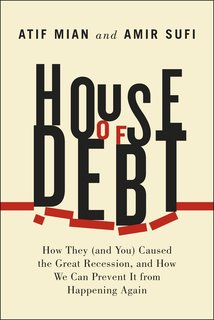 There's a warning that often appears in personal finance books: "Leverage cuts both ways." Because people usually borrow 80% or 90% of the price when buying a home, any gains due to an increase in the price are magnified - but any losses due to a decline are magnified as well.
There's a warning that often appears in personal finance books: "Leverage cuts both ways." Because people usually borrow 80% or 90% of the price when buying a home, any gains due to an increase in the price are magnified - but any losses due to a decline are magnified as well.
In House of Debt (2014), a striking analysis of the 2007 housing crash and post-2008 recession, economists Atif Mian and Amir Sufi explain that when house prices decline, it's the borrower who bears the losses.
Debt plays such a common role in the economy that we often forget how harsh it is. The fundamental feature of debt is that the borrower must bear the first losses associated with a decline in asset prices. For example, if a home owner buys a home worth $100,000 using an $80,000 mortgage, then the home owner's equity in the home is $20,000. If house prices drop 20 percent, the home owner loses $20,000 - their full investment - while the mortgage lender escapes unscathed. If the home owner sells the home for the new price of $80,000, they must use the full proceeds to pay off the mortgage. They walk away with nothing. In the jargon of finance, the mortgage lender has the senior claim on the home and is therefore protected if house prices decline. The home owner has the junior claim and experiences huge losses if house prices decline.
But we shouldn't think of the mortgage lender in this example as an independent entity. The mortgage lender uses money from savers in the economy. Savers give money to the bank either as deposits, debt, or equity, and are therefore the ultimate owners of the mortgage bank. When we say that the mortgage lender has the senior claim on the home, what we really mean is that savers in the economy have the senior claim on the home. Savers, who have high net worth, are protected against house-price declines much more than borrowers.
Now let's take a step back and consider the entire economy of borrowers and savers. When house prices in the aggregate collapse by 20 percent, the losses are concentrated on the borrowers in the economy. Given that borrowers already had low net worth before the crash (which is why they needed to borrow), the concentration of losses on them devastates their financial condition. They already had very little net worth - now they have even less. In contrast, the savers, who typically have a lot of financial assets and little mortgage debt, experience a much less severe decline in their net worth when house prices fall. This is because they ultimately own - through their deposits, bonds, and equity holdings - the senior claims on houses in the economy. House prices may fall so far that even the senior claims take losses, but they are much less severe than the devastation wrought on the borrowers.
Mian and Sufi go on to examine the distribution of losses due to the $5.5 trillion decline in US house prices during the recession. In 2007, for the bottom 20% of households, nearly all their net worth was in home equity, and their debt-to-asset ratio was 80%. For the top 20%, nearly all their net worth was in financial assets, and their debt-to-asset ratio was only 7%. They summarize:
The net worth of poor home owners was absolutely hammered during the Great Recession [when house prices fell 30%]. From 2007 to 2010, their net worth collapsed from $30,000 to almost zero. This is the leverage multiplier at work. The decline in net worth during the Great Recession completely erased all the gains from 1992 to 2007.
In contrast, the top 20% of households were barely affected.
As the net worth of highly levered households declined, they cut back their spending - Mian and Sufi use county-level data to back this up. This in turn led to job losses across the entire economy.
Mian and Sufi conclude by proposing a more equity-like structure for mortgages, where the lender would absorb part of the loss due to a decline in house prices, in exchange for a modestly higher rate of return.